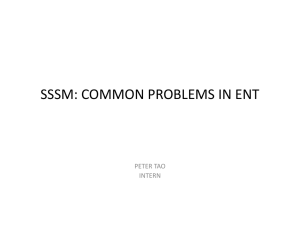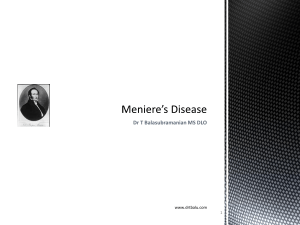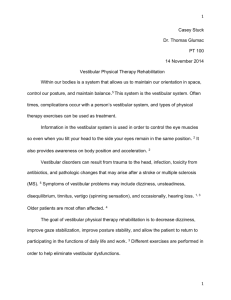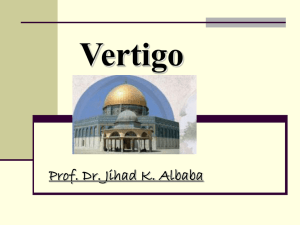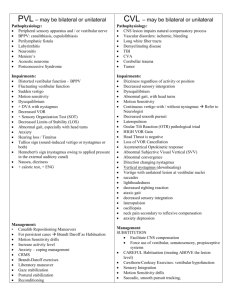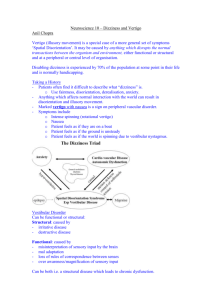Vestibular Disorders
advertisement
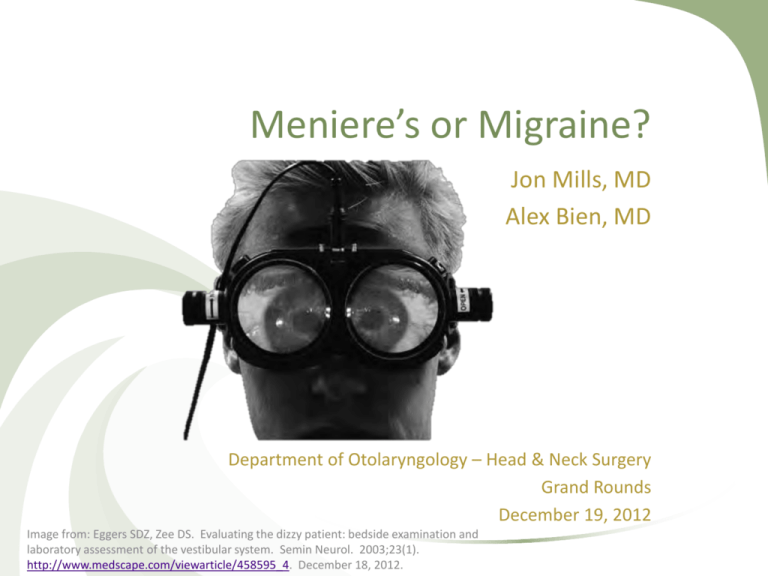
Meniere’s or Migraine? Jon Mills, MD Alex Bien, MD Department of Otolaryngology – Head & Neck Surgery Grand Rounds December 19, 2012 Image from: Eggers SDZ, Zee DS. Evaluating the dizzy patient: bedside examination and laboratory assessment of the vestibular system. Semin Neurol. 2003;23(1). http://www.medscape.com/viewarticle/458595_4. December 18, 2012. Time Type Visit Reason 8:00 NEW Dizzy – URGENT add-on OK per on-call doc 8:15 NEW Huge tonsils 8:30 NEW Chip shot septum 8:45 RET Post-op tympanoplasty 9:00 RET Tube check 9:15 NEW Really wants surgery 9:30 RET Post-op tonsil 9:45 NEW Wants blepharoplasty 10:00 NEW Parathyroid adenoma 10:15 RET Tube check 10:30 NEW Needs tubes 10:45 NEW Neck mass 11:00 RET Discuss surgery 11:15 NEW Parotid mass 11:30 RET Post-op rhinoplasty Your Patient • 31 yo M. Chief complaint: I’m Dizzy. Preliminary Investigation of Mindful Preparedness (a.k.a. PIMP) • Primary purposes of vestibular reflexes are to preserve: a) b) c) d) e) Posture Orientation Vision Both a) and c) All of the above PIMP • Sudden loss of right peripheral vestibular function would result in: a) b) c) d) Right-beating nystagmus Left-beating nystagmus Oscillopsia Severe giddiness PIMP • Meniere’s Disease may be bilateral in approximately what percentage of patients? a) b) c) d) e) 1% 7% 20% 50% 80% PIMP • Patient presents to you complaining of vertigo. Her most likely diagnosis is: a) b) c) d) e) Meniere’s Disease Migraine-Associated Vertigo Both Meniere’s and Migraine Syphilis Idiopathic psychosomatic dizziness PIMP • A patient presents with migraine-associated vertigo. She is most likely also to complain of: a) b) c) d) e) Tinnitus Hearing loss Photophobia Phonophobia Visual aura Vestibular Physiology • Reflexes to preserve vision and posture – Vision via vestibulo-ocular reflex (VOR) – Posture via vestibulocolic (VCR) and vestibulospinal (VSR) reflexes • Vestibular function most important for high-frequency, highvelocity, and high-acceleration movements • At slower speeds, visually-driven reflexes (smooth pursuit) and proprioception can compensate for vestibular deficiency Carey JP. Principles of applied vestibular physiology. In: Flint PW, Haughey BH, Lund VJ, Niparko JK, Richardson MA, Robbins KT, Thomas JR, editors. Cummings Otolaryngology Head and Neck Surgery, Fifth Edition. Philadelphia: Mosby; 2010. p. 2276 – 2304. Vestibular Physiology • Semicircular canals: encode rotation • Otolith organs: encode linear acceleration and tilt • Ewald’s First Law: – Stimulation of a semicircular canal produces eye movements in the plane of that canal. Carey JP. Principles of applied vestibular physiology. In: Flint PW, Haughey BH, Lund VJ, Niparko JK, Richardson MA, Robbins KT, Thomas JR, editors. Cummings Otolaryngology Head and Neck Surgery, Fifth Edition. Philadelphia: Mosby; 2010. p. 2276 – 2304. Vestibular Physiology • A semicircular canal is excited by rotation of head toward ipsilateral side – Lateral SCC: excited by ampullopetal flow of endolymph – Superior and Posterior SCCs: excited by ampullofugal flow • Ewald’s Second Law: High-acceleration head rotation in excitatory direction of a canal elicits greater response than same rotation in inhibitory direction • Nystagmus due to dysfunction of SCCs has a fixed axis and direction with respect to the head – Primary way to distinguish peripheral and central nystagmus Carey JP. Principles of applied vestibular physiology. In: Flint PW, Haughey BH, Lund VJ, Niparko JK, Richardson MA, Robbins KT, Thomas JR, editors. Cummings Otolaryngology Head and Neck Surgery, Fifth Edition. Philadelphia: Mosby; 2010. p. 2276 – 2304. Vestibular Physiology • Alexander’s Law: – When eyes look toward direction of fast phase of nystagmus, velocity of slow phase increases. – When eyes look toward direction of slow phase of nystagmus, velocity of slow phase decreases. – Generally obeyed by peripheral causes, not by central causes Carey JP. Principles of applied vestibular physiology. In: Flint PW, Haughey BH, Lund VJ, Niparko JK, Richardson MA, Robbins KT, Thomas JR, editors. Cummings Otolaryngology Head and Neck Surgery, Fifth Edition. Philadelphia: Mosby; 2010. p. 2276 – 2304. Vestibular Physiology • Loss of unilateral utricular function interpreted as head tilt toward the opposite side • Sudden changes in saccular activity cause changes in postural tone – Sudden excitation activation of extensors, relaxation of flexors – Sudden inhibition relaxation of extensors, activation of flexors • Results in loss of postural tone Carey JP. Principles of applied vestibular physiology. In: Flint PW, Haughey BH, Lund VJ, Niparko JK, Richardson MA, Robbins KT, Thomas JR, editors. Cummings Otolaryngology Head and Neck Surgery, Fifth Edition. Philadelphia: Mosby; 2010. p. 2276 – 2304. Approach to the Dizzy Patient • Lifetime prevalence of vestibular vertigo: 7.4% • 80% will result in medical consultation, interruption of daily activities, or time off work Crane BT, Schessel DA, Nedzelski J, Minor JB. Peripheral vestibular disorders. In: Flint PW, Haughey BH, Lund VJ, Niparko JK, Richardson MA, Robbins KT, Thomas JR, editors. Cummings Otolaryngology Head and Neck Surgery, Fifth Edition. Philadelphia: Mosby; 2010. p. 2328 – 2345. Image from: http://www.metrohealth.org/body.cfm?id=1507. December 18, 2012. Vertigo History – Key Elements • • • • • • Duration of attacks Frequency of attacks Effect of head movements Relation to specific position Associated aural symptoms Concomitant ear disease Crane BT, Schessel DA, Nedzelski J, Minor JB. Peripheral vestibular disorders. In: Flint PW, Haughey BH, Lund VJ, Niparko JK, Richardson MA, Robbins KT, Thomas JR, editors. Cummings Otolaryngology Head and Neck Surgery, Fifth Edition. Philadelphia: Mosby; 2010. p. 2328 – 2345. Vertigo History – Key Elements • Duration of attacks • • • • • Frequency of attacks Effect of head movements Relation to specific position Associated aural symptoms Concomitant ear disease Crane BT, Schessel DA, Nedzelski J, Minor JB. Peripheral vestibular disorders. In: Flint PW, Haughey BH, Lund VJ, Niparko JK, Richardson MA, Robbins KT, Thomas JR, editors. Cummings Otolaryngology Head and Neck Surgery, Fifth Edition. Philadelphia: Mosby; 2010. p. 2328 – 2345. Historical Background of Vertigo • Prior to 1860: thought to be central problem – “cerebral congestion” – Treatment: leaching, purging, cupping • 1861: Prosper Meniere – Hearing loss and vertigo have common inner ear origin – Autopsy of young girl after trauma caused hearing loss and vertigo • Brain normal, but found hemorrhage in inner ear • Prior to 1940, “Meniere’s disease” used to describe any peripheral vertigo Crane BT, Schessel DA, Nedzelski J, Minor JB. Peripheral vestibular disorders. In: Flint PW, Haughey BH, Lund VJ, Niparko JK, Richardson MA, Robbins KT, Thomas JR, editors. Cummings Otolaryngology Head and Neck Surgery, Fifth Edition. Philadelphia: Mosby; 2010. p. 2328 – 2345. Meniere’s Disease – Epidemiology • • • • • • • Prevalence 218 per 100,000 in U.S. Male to Female 1:1 More prevalent among whites Peak age of onset 4th – 5th decade Bilateral in 19-24% Familial in 10-20% - strong association with migraine HLA B8/DR3 and Cw7 – autoimmune? Derebery MJ. Allergic and immunologic features of Meniere’s disease. Otolaryngol Clin N Am. 2011;44:655-666. Crane BT, Schessel DA, Nedzelski J, Minor JB. Peripheral vestibular disorders. In: Flint PW, Haughey BH, Lund VJ, Niparko JK, Richardson MA, Robbins KT, Thomas JR, editors. Cummings Otolaryngology Head and Neck Surgery, Fifth Edition. Philadelphia: Mosby; 2010. p. 2328 – 2345. Meniere’s Disease - Pathogenesis • No single theory 100% accepted • Distortion of membranous labyrinth – Dilation of endolymphatic space at expense of perilymphatic space – “endolymphatic hydrops” • Endolymph produced by stria vascularis (cochlea) and dark cells (vestibular labyrinth), absorbed in endolymphatic sac • Too much production? • Inadequate absorption? • Temporal bone studies: all patients with Meniere’s have hydrops, but not all patients with hydrops have Meniere’s Crane BT, Schessel DA, Nedzelski J, Minor JB. Peripheral vestibular disorders. In: Flint PW, Haughey BH, Lund VJ, Niparko JK, Richardson MA, Robbins KT, Thomas JR, editors. Cummings Otolaryngology Head and Neck Surgery, Fifth Edition. Philadelphia: Mosby; 2010. p. 2328 – 2345 Image from: http://www.bioon.com/bioline/neurosci/course/audvest.html. December 18, 2012. Meniere’s Disease - Pathogenesis • Schuknecht – periodic ruptures in membranous labyrinth allow high potassium endolymph to enter perilymphatic space – – – – Nerve cells depolarize and become deactivated Acute hearing loss and vestibular dysfunction Recovery as membrane heals Repeated insults cause permanent dysfunction Crane BT, Schessel DA, Nedzelski J, Minor JB. Peripheral vestibular disorders. In: Flint PW, Haughey BH, Lund VJ, Niparko JK, Richardson MA, Robbins KT, Thomas JR, editors. Cummings Otolaryngology Head and Neck Surgery, Fifth Edition. Philadelphia: Mosby; 2010. p. 2328 – 2345. Meniere’s Disease - Pathogenesis • • • • • • Autoimmune process? Allergy? Viral infection? Ischemia/vascular mechanism? Multifactorial? Common endpoint for a variety of mechanisms/insults? Meniere’s Disease – Role of Allergy? • • • • Increased levels of circulating immune complexes (ICs) More severe Meniere’s more likely to have circulating ICs Larger elevations in ICs in bilateral disease Elevated total IgE in 43% Meniere’s patients, vs 20% for controls • 67% of Meniere’s pts with positive allergy history, vs 35% of controls • Improvement of vertigo, tinnitus, and unsteadiness after desensitization with immunotherapy and selective food avoidance – Antihistamine alone not sufficient Derebery MJ. Allergic and immunologic features of Meniere’s disease. Otolaryngol Clin N Am. 2011;44:655-666. Meniere’s Disease – Diagnosis 1995 AAO-HNS Guidelines Possible Meniere’s Probable Meniere’s • Episodic vertigo without • One definitive episode hearing loss, or of vertigo • SNHL with • HL documented by dysequilibrium but audiogram without definite • Tinnitus or aural episodes fullness • Other causes excluded • Other causes excluded Definite Meniere’s • Two or more definitive episodes of spontaneous vertigo lasting >20 minutes • HL documented by audiogram • Tinnitus or aural fullness • Other causes excluded Crane BT, Schessel DA, Nedzelski J, Minor JB. Peripheral vestibular disorders. In: Flint PW, Haughey BH, Lund VJ, Niparko JK, Richardson MA, Robbins KT, Thomas JR, editors. Cummings Otolaryngology Head and Neck Surgery, Fifth Edition. Philadelphia: Mosby; 2010. p. 2328 – 2345. Meniere’s Disease - History • Recurring attacks of vertigo – 96% – Minutes to hours, typically 2-3 hours – If attacks last longer than 1 day, diagnosis more in doubt • Tinnitus – 91% • Unilateral hearing loss – 88% • Attacks often preceded by aura – Fullness in ear – Increasing tinnitus – Decrease in hearing • May have clustered attacks with otherwise long remissions • Vertigo may spontaneously cease – 57% at 2 years – 71% at 8 years Crane BT, Schessel DA, Nedzelski J, Minor JB. Peripheral vestibular disorders. In: Flint PW, Haughey BH, Lund VJ, Niparko JK, Richardson MA, Robbins KT, Thomas JR, editors. Cummings Otolaryngology Head and Neck Surgery, Fifth Edition. Philadelphia: Mosby; 2010. p. 2328 – 2345. Meniere’s Disease – Drop Attacks • A.k.a. Otolithic Crises of Tumarkin • Acute utriculosaccular dysfunction – Generates abrupt change in vertical gravity reference – Leads to inappropriate change in postural tone via vestibulospinal pathway • May describe feeling of being suddenly “pushed” • 2 – 6% of Meniere’s patients • May occur in clusters then spontaneously remit Crane BT, Schessel DA, Nedzelski J, Minor JB. Peripheral vestibular disorders. In: Flint PW, Haughey BH, Lund VJ, Niparko JK, Richardson MA, Robbins KT, Thomas JR, editors. Cummings Otolaryngology Head and Neck Surgery, Fifth Edition. Philadelphia: Mosby; 2010. p. 2328 – 2345. Meniere’s Disease – Physical Exam • Rare to see patient in acute attack – Expect horizontal nystagmus – Nystagmus changes in direction over course of attack • Thus NOT useful in identifying affected ear • May note unilateral weakness with head thrust – Present in 29% of patients Crane BT, Schessel DA, Nedzelski J, Minor JB. Peripheral vestibular disorders. In: Flint PW, Haughey BH, Lund VJ, Niparko JK, Richardson MA, Robbins KT, Thomas JR, editors. Cummings Otolaryngology Head and Neck Surgery, Fifth Edition. Philadelphia: Mosby; 2010. p. 2328 – 2345. Meniere’s Disease – Diagnostic Tests • NO single test is diagnostic • Videonystagmography (VNG) – unilateral weakness on calorics in 48 – 73% – Total absence of caloric response in 6 – 11% • Electrocochleography (ECoG) – summating potential may be larger and more negative, leads to elevation of summating potential to action potential ratio (SP/AP). – Present in 62% of Meniere’s, but also in 21% of normals – Test not routinely used • Vestibular Evoked Myopotentials (VEMPs) – thresholds may be elevated – Not very useful due to large individual variation Crane BT, Schessel DA, Nedzelski J, Minor JB. Peripheral vestibular disorders. In: Flint PW, Haughey BH, Lund VJ, Niparko JK, Richardson MA, Robbins KT, Thomas JR, editors. Cummings Otolaryngology Head and Neck Surgery, Fifth Edition. Philadelphia: Mosby; 2010. p. 2328 – 2345. Meniere’s Disease – Management Principles • Chronic disease that can be managed, but not treated • Possible aims of management 1) Reducing the number and severity of acute vertigo attacks 2) Aborting or ameliorating hearing loss associated with attacks 3) Alleviating chronic tinnitus and/or imbalance 4) Preventing progression of disease • No treatment option addresses all of these goals • Typically main goal is number (1) above Coelho DH, Lalwani AK. Medical management of Meniere’s disease. Laryngoscope. 2008;118:1099-1108. Meniere’s Disease – Medical Management • Acute management – – – – Benzodiazepines – good vestibular suppressant and anxiolytic Antihistamines (meclizine) – caution about anticholinergic side effects Antiemetics Corticosteroids (short burst/taper, intratympanic) • Chronic management – Lifestyle changes (trigger avoidance): • Salt, MSG, caffeine, nicotine, alcohol, stress, fatigue, allergy – Salt restriction – little evidence to support, but most recommend • No added salt. Restrict to less than 2g sodium per day. – Pharmacotherapy Coelho DH, Lalwani AK. Medical management of Meniere’s disease. Laryngoscope. 2008;118:1099-1108. Meniere’s Disease – Medical Management Diuretics • HCTZ most common, also loop diuretics (furosemide), potassium-sparing diuretics (spironolactone), and carbonic anhydrase inhibitors (acetazolamide) • Evidence limited – recent Cochrane review found no highquality studies that met inclusion criteria – Lower quality research tends to support use • Diuretics and salt restriction – Complete or substantial vertigo control in 79%, limited or insignificant control in 19%, worse in 2% – Stabilization of low-mid frequency HL (average 0 dB loss at 74 months) • HL improved in 35%, unchanged in 29%, worse in 20% • Slowly taper off when symptom-free for 6-12 months Coelho DH, Lalwani AK. Medical management of Meniere’s disease. Laryngoscope. 2008;118:1099-1108. Meniere’s Disease – Medical Management Intratympanic steroids • Intratympanic appealing due to lack of systemic side effects • Cochrane review identified one RCT – 5 days of IT dexamethasone, outcome measured at 2 years. – 82% with complete vertigo control vs 57% for placebo – 90% with improved functional level vs 42% for placebo – 35% with subjective hearing improvement vs 10% for placebo • No difference for PTA or speech discrim – 48% with tinnitus improvement vs 20% for placebo Phillips JS, Westerberg B. Intratympanic steroids for Meniere’s disease or syndrome. Cochrane Database Syst Rev. 2011;6:CD008514. Meniere’s Disease – Medical Management Intratympanic Gentamycin • “Chemical labyrinthectomy” • Single injection sufficient in majority, 15-20% require second injection at 1 month. • 76% vertigo improvement and no hearing change at 4 years • CAUTION: 20% of patients develop bilateral Meniere’s. – Can result in disabling oscillopsia and disequilibrium Coelho DH, Lalwani AK. Medical management of Meniere’s disease. Laryngoscope. 2008;118:1099-1108. Meniere’s Disease – Medical Management Other • Vasodilators – not much evidence to support – Niacin, papaverine, isosorbide dinitrate, histamine, betahistine • Alternative/Homeopathic Treatments – 42% of patients have used or are using • 75% of these do not tell their physician – Gingko biloba, lipoflavinoids, ginger root, acupuncture, Tai Chi – Chiropractic: Suggest common link between Meniere’s, Parkinson’s, trigeminal neuralgia, Bell’s palsy, TMJ, and cervical spine disease Coelho DH, Lalwani AK. Medical management of Meniere’s disease. Laryngoscope. 2008;118:1099-1108. Meniere’s Disease – Medical Management Other • Meniett Device – available in US since 2000 – – – – – – – Alternating low-intensity pressure generator Requires placement of PE tube Found to be effective in short (RCT) and long-term (cohort) 69% achieve either complete remission or greatly improved vertigo Problems with “blinding” in these studies No benefit for hearing Expensive and not covered by insurance ($3500) Coelho DH, Lalwani AK. Medical management of Meniere’s disease. Laryngoscope. 2008;118:1099-1108. Meniere’s Disease – Surgical Management • Endolymphatic sac surgery – Nonablative • Vestibular nerve section – Ablative – Potential to preserve hearing • Labyrinthectomy – Ablative – No hearing preservation Migraine-Associated Vertigo (MAV) a.k.a. Vestibular Migraine • • • • Migraine prevalence: 10% of population 1/3 of migraine patients report some type of dizziness Prevalence of migraine-associated vertigo: 1% of population 5 – 10 times more prevalent than Meniere’s disease Cherchi M, Hain TC. Migraine-associated vertigo. Otolaryngol Clin N Am. 2011;44:367-375. MAV: Definition Neuhauser and Lempert (2009) Definite MAV Probable MAV • Episodic vestibular symptoms of at least moderate severity • Current or previous history of migraine (according to ICHD-II criteria) • One of the following symptoms during two or more attacks of vertigo: migrainous headache, photophobia, phonophobia, visual aura, or other aura • Episodic vestibular symptoms of at least moderate severity • One of the following: (1) Current or previous history of migraine (according to ICHD-II criteria). (2) Migrainous symptoms during vestibular symptoms (3) Migraine precipitants of vertigo in more than 50% of attacks (food triggers, sleep irregularities, hormonal change) (4) Response to migraine medications in more than 50% of attacks • Other causes ruled out • Other causes ruled out Neuhauser H, Lempert T. Vestibular migraine. Neurol Clin. 2009;27:379-391. MAV: Epidemiology • Female preponderance: 1.5 – 5 : 1 • May be familial (autosomal dominant with incomplete penetrance) • More common in patients with migraine without aura • Approximately 50% of Meniere’s patients meet criteria for migraine Cherchi M, Hain TC. Migraine-associated vertigo. Otolaryngol Clin N Am. 2011;44:367-375. MAV: Pathophysiology MAV: Pathophysiology • “Spreading depression” – Responsible for other migraine auras – May only apply to minority of cases of vestibular migraine – Occurs at level of cerebral cortex • Unilateral release of specific neurotransmitters • Cross-talk between trigeminal and vestibular nuclei – Painful electrical stimulation of forehead produces nystagmus in migraine patients but not in controls Neuhauser H, Lempert T. Vestibular migraine. Neurol Clin. 2009;27:379-391. MAV: History • • • • • • Rotational vertigo: 70% Intolerance of head motion: 48% Positional vertigo: 42% Intolerance of visual motion Onset variable – ranges from gradual to abrupt Duration of episodes variable – – – – 5 – 60 minutes: 33% 1 – 24 hours: 21% Seconds to 5 minutes: 18% More than 24 hours: 2% Neuhauser H, Lempert T. Vestibular migraine. Neurol Clin. 2009;27:379-391. MAV: History • Frequency of migraine headache with episodes: – 45% have consistently – 48% have sometimes – 6% never have • Other migraine symptoms with episodes: – Photophobia: 70% – Phonophobia: 64% – Auras other than vertigo: 36% • Other aural symptoms: – Tinnitus: 63% – Hearing loss: 32% – Fluctuating hearing loss and aural fullness: 11% • Triggers identified in minority Neuhauser H, Lempert T. Vestibular migraine. Neurol Clin. 2009;27:379-391. MAV: Physical Exam • Typically normal • May note nystagmus if Frenzel lens used Cherchi M, Hain TC. Migraine-associated vertigo. Otolaryngol Clin N Am. 2011;44:367-375. MAV: Diagnostic testing • Typically done to rule out other disorders • VNG, VEMP, audiometry may be considered • MRI – usually normal – Higher prevalence of punctate white matter changes in migraine patients Cherchi M, Hain TC. Migraine-associated vertigo. Otolaryngol Clin N Am. 2011;44:367-375. MAV: Medical Management • • • • • • Based primarily on expert opinion Evaluate treatment after 3 months Reasonable goal is 50% reduction in attack frequency Keep log, try to identify triggers Avoidance of triggers, regular sleep, regular exercise Acute Management: – Triptans: effect on vertigo correlated to effect on headache – Vestibular suppressants • Prophylactic medications: – Indicated if attacks frequent (>1 per week) and/or severe Cherchi M, Hain TC. Migraine-associated vertigo. Otolaryngol Clin N Am. 2011;44:367-375. MAV: Medical Management • Prophylactic medications Cherchi M, Hain TC. Migraine-associated vertigo. Otolaryngol Clin N Am. 2011;44:367-375. Summary • The most important component of the evaluation of any dizzy patient is a structured history • There is no test that is diagnostic for Meniere’s disease or vestibular migraine • Pathogenesis of Meniere’s disease still unknown, and may be multifactorial and/or the end result of multiple pathologic processes • In many cases Meniere’s and vestibular migraine are easily distinguished by history, but there is a significant overlap. – Must consider possibility of both diagnoses being present • Current management of both Meniere’s and vestibular migraine based on incomplete body of evidence. References 1) 2) 3) 4) 5) 6) 7) 8) Eggers SDZ, Zee DS. Evaluating the dizzy patient: bedside examination and laboratory assessment of the vestibular system. Semin Neurol. 2003;23(1). http://www.medscape.com/viewarticle/458595_4. December 18, 2012. Carey JP. Principles of applied vestibular physiology. In: Flint PW, Haughey BH, Lund VJ, Niparko JK, Richardson MA, Robbins KT, Thomas JR, editors. Cummings Otolaryngology Head and Neck Surgery, Fifth Edition. Philadelphia: Mosby; 2010. p. 2276 – 2304. Crane BT, Schessel DA, Nedzelski J, Minor JB. Peripheral vestibular disorders. In: Flint PW, Haughey BH, Lund VJ, Niparko JK, Richardson MA, Robbins KT, Thomas JR, editors. Cummings Otolaryngology Head and Neck Surgery, Fifth Edition. Philadelphia: Mosby; 2010. p. 2328 – 2345. Derebery MJ. Allergic and immunologic features of Meniere’s disease. Otolaryngol Clin N Am. 2011;44:655-666. Coelho DH, Lalwani AK. Medical management of Meniere’s disease. Laryngoscope. 2008;118:1099-1108. Phillips JS, Westerberg B. Intratympanic steroids for Meniere’s disease or syndrome. Cochrane Database Syst Rev. 2011;6:CD008514. Cherchi M, Hain TC. Migraine-associated vertigo. Otolaryngol Clin N Am. 2011;44:367-375. Neuhauser H, Lempert T. Vestibular migraine. Neurol Clin. 2009;27:379-391.
